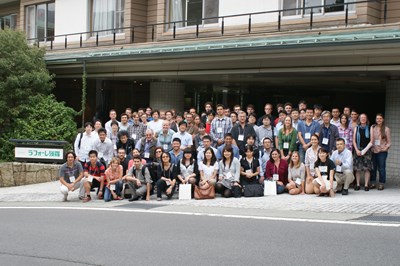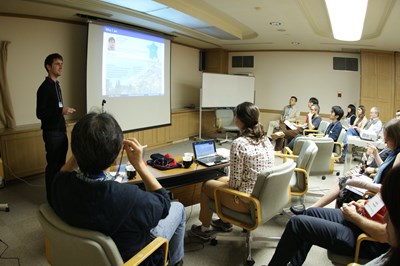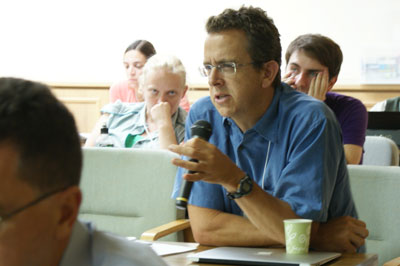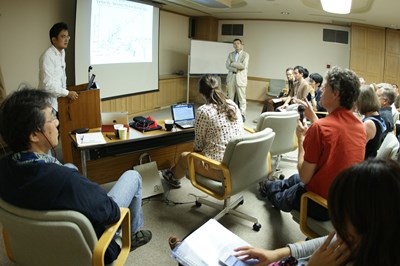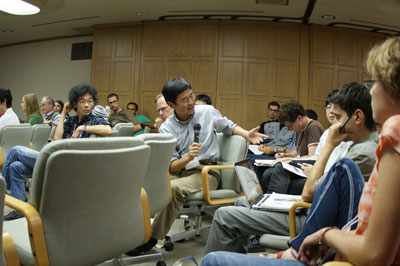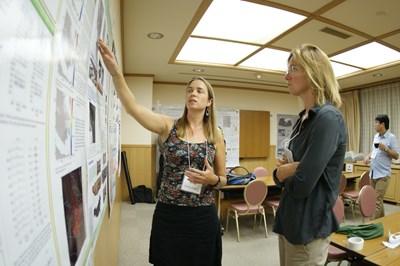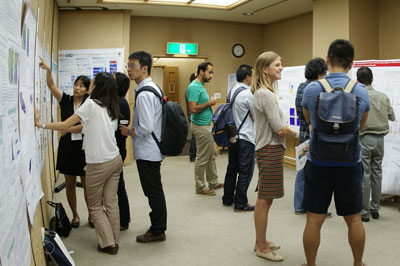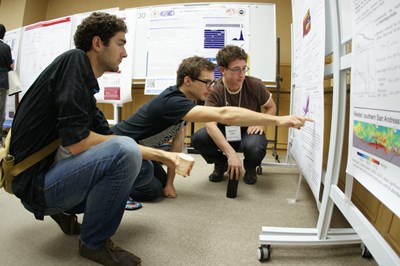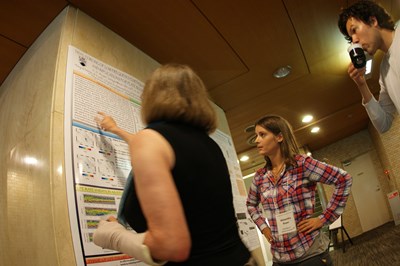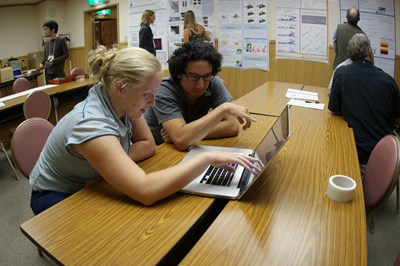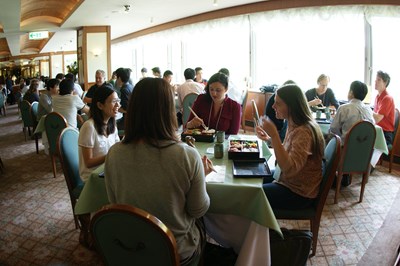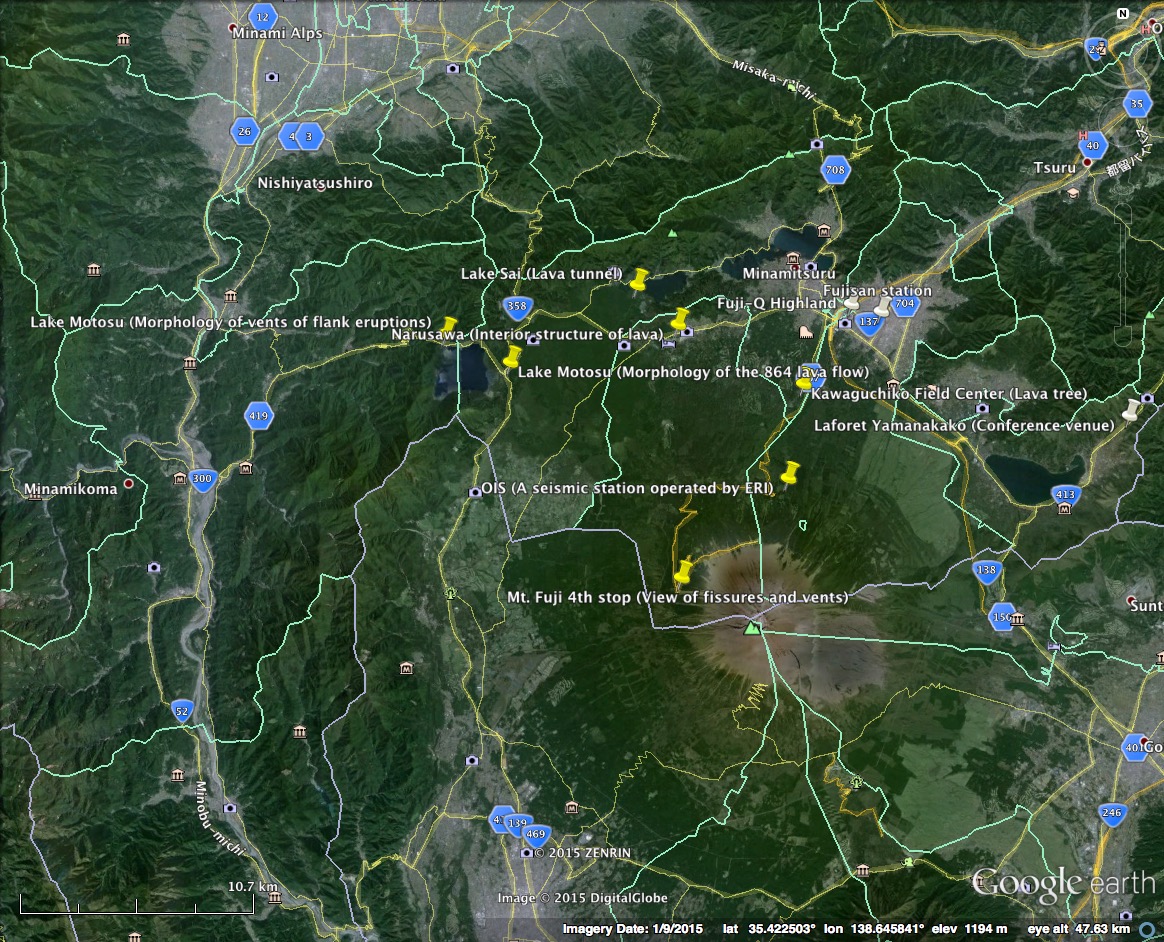The 3rd international summer school on Earthquake Science
“Monitoring physical properties associated with tectonic processes”
Program (20150902) Poster
| September 4 (Friday) | |
|---|---|
| 13:00 | Registration (Rooms will be ready at 3 pm.) |
| 18:00 & 20:00- | Icebreaker (light dinner and drinks) @ Ginga |
| September 5 (Saturday) | |
| 7:00 - 8:30 | Breakfast @ Dining |
| 8:45 - 9:00 | Introduction and logistics |
| Session 3: Monitoring seismicity | |
| 9:00 - 10:30 | Lecture Felix Waldhauser (Lamont-Doherty Earth Observatory) Resolving and monitoring changes in seismicity and seismogenic properties |
| 10:30 - 11:00 | Coffee |
| 11:00 - 12:30 | Lecture Heidi Houston (University of Washington) Tidal influence on slow slip and tremor: A window into the physical environment deep in subduction zones |
| 12:45 - 13:45 | Lunch @ Dining |
| 14:00 - 15:00 | Presentations by students/postdocs (1) Suguru Yabe: Understanding of tremor and slow slip through simulation study (2) Ryo Okuwaki: What determines rupture extent? Insights from high-frequency radiation and co-seismic slip during the Mw 7.9 2015 Gorkha Nepal earthquake, and its aftershock activity. (3) Wenyuan Fan: How much can we hope to resolve earthquake rupture process with back-projection? |
| 15:00 - | Poster core time |
| 15:30 - 16:30 | Coffee |
| 16:30 - 18:00 | Lecture Kazushige Obara (ERI, University of Tokyo) How to discover non-volcanic tremor -Effective monitoring- |
| 18:30 - 20:00 | Dinner @ Dining |
| 20:00 - | Free discussion |
| September 6 (Sunday) | |
| 7:00 - 8:30 | Breakfast @ Dining |
| 9:00 - 10:30 | Lecture Emily Brodsky (University of California Santa Cruz) The Uses of Dynamic Earthquake Triggering |
| 10:30 - 11:00 | Coffee |
| Session 1: Monitoring seismic velocity structure with seismic interferometry | |
| 11:00 - 12:30 | Lecture Eric Larose (Institut des Sciences de la Terre, CNRS and Universit´e de Grenoble) Ambiant seismic noise: from imaging to monitoring mechanical changes |
| 12:30 - 13:30 | Lunch @ Dining |
| 14:00 - 15:00 | Presentations by students/postdocs (1) Brent Delbridge: Geodetic Signature of Slow-Slip and Tremor in Parkfield, CA (2) Camilla Catania: A slow rupture episode during the 2000 Miyakejima dike intrusion (3) Loïc Viens: Toward Complete Extraction of Basin-scale Green's functions from the Ambient Seismic Field |
| 15:00 - | Poster core time |
| 15:30 - 16:30 | Coffee |
| 16:30 - 18:00 | Lecture Victor Tsai (California Institute of Technology) Pushing the Limits of Ambient Seismic Noise |
| 18:30 - 20:00 | Dinner @ Dining |
| 20:00 - | Free discussion |
| September 7 (Monday) | |
| 7:00 - 8:30 | Breakfast @ Dining |
| Session 2: Monitoring crustal deformation | |
| 9:00 - 10:30 | Lecture Kosuke Heki (Hokkaido University) Space geodetic approaches in earthquake science: time-variable gravity, crustal movements, and polar motion |
| 10:30 - 11:00 | Coffee |
| 11:00 - 12:30 | Lecture Rowena Lohman (Cornell University) Geodetic imaging of earthquake sources - from high rate GPS to InSAR and beyond |
| 12:30 - 13:30 | Lunch @ Dining |
| Posters | |
| 15:30 - 16:30 | Coffee |
| Session 3: Monitoring seismicity | |
| 16:30 - 18:00 | Lecture Hiroyuki Kumagai (Nagoya University) Broadband seismic monitoring of active volcanoes |
| 18:30 - 20:00 | Banquet @ Ginga |
| 20:00 - | Free discussion |
| September 8 (Tuesday) | |
| 7:00 - 8:00 | Breakfast @ Dining |
| Check out & adjourn | |
| 8:30 | (Optional) Field trip to Mt. Fuji (*) |
(*) Field trip:
An optional field trip on 8 September will leave the hotel at around 8:30am and make stops at a few locations including a seismic site operated by ERI to monitor Mt. Fuji and geological sites which allow you to observe the structure of lava flows associated with the 864 eruption. We will break up at about 15:00 at Fuji-Q Highland bus terminal & Fujisan station.
Yellow pins in the map show candidate stops of the field trip. White pins indicate Laforet Yamanakako, Fuji-Q Highland bus terminal & Fujisan station. (click the map to enlarge in other window)
| Posters (20150831) |
| Hans Agurto-Detzel Intraplate seismicity in mid-plate South America: correlations with geological and geophysical lithospheric properties |
| Takeshi Akuhara Hydrous state of the subducting Philippine Sea plate inferred from receiver function image using onshore and offshore data |
| Rafael Almeida A snapshot of a dynamic system: what can we learn about active faults using active-source seismic data? An example from Central Nepal |
| María Araya Application of the double difference earthquake location algorithm with HypoDD to the seismic sequences of Tobosi 2011-2012, San Isidro and Llano Grande (A&B), 2015 at Central Costa Rica |
| Magali Barba Postseismic Deformation Of Mojave Earthquakes using InSAR Time-Series Analysis |
| Anselme Borgeaud SHdiff-SVdiff splitting for transversely isotropic and anelastic media |
| Masyitha Budiati How could regional depth phases estimate focal depths along Palu Koro Fault and subduction zone in Northern Sulawesi Island, Indonesia? |
| Birsen Can Analysis and Classification of Physical Characteristics of Earthquake Clusters in Eastern Marmara Using PIRES Array Data |
| Camilla Cattania A slow rupture episode during the 2000 Miyakejima dike intrusion |
| Yifang Cheng Effect of geothermal operations on seismicity characteristics in the Salton Sea geothermal field |
| Brent Delbridge Geodetic Measurements of Slow Slip and Tremor in Parkfield, CA |
| Islam Fadel Surface wave analysis of Botswana using ambient noise and two-station methods |
| Pegah Faegh-Lashgary Rupture during the Mw 7.1 Darfield earthquake possibly induced by postseismic stress changes following the Mw 7.8 Dusky Sound earthquake 14 months earlier |
| Wenyuan Fan How much can we hope to resolve in earthquake rupture processes with back-projection? |
| Anna Foster Focal mechanisms for the 2015 Gorkha earthquake aftershock sequence |
| Dara Goldberg The Role of Real-Time GNSS in Earthquake and Tsunami Early Warning |
| Francesco Grigoli Full-waveform location methods in microseismic monitoring operations |
| Mari Hamahashi The impact of mass movement and fluid flow during ridge subduction inferred from physical properties and zeolite assemblage in the upper plate slope of the Costa Rica subduction zone |
| Jiangang Han Deep long-period earthquakes (DLPs) beneath Mount St. Helens |
| Alexandra Hutchison Very low frequency earthquakes in Cascadia during episodic and tremor and slip events in 2011, 2013, and 2014 |
| Misae Imano Accuracy assessment in GPS/Acoustic positioning using a moored buoy moving around far from the optimal position |
| Asaf Inbal Depth-dependant earthquake properties beneath Long-Beach, CA: Implications for the rheology at the brittle-ductile transition zone |
| Yang Jiang 3-D virtual deep seismic sounding of thickened Tibetan crust |
| Chihiro Kinoshita Change of Rock Permeability Induced by the 2011 Tohoku Earthquake |
| Ryo Kurihara Inland triggered tremor: Automated detection method and observation in Southern Gumma prefecture, Central part of Japan |
| Hobin Lim Seismicity and structure of Nazca Plate subduction zone in southern Peru |
| Pei-Ying Patty Lin Constraining deformation and flow in the oceanic mantle: the local view from the NoMelt experiment in the central Pacific |
| Julie Maury Very Low Frequency earthquakes associated with tectonic tremors in Guerrero, Mexico |
| Angela Meneses Persistent aseismic deformation in Central Japan revealed by GPS observation before and after the Tohoku-Oki Earthquake |
| Norimitsu Nakata Monitoring of Seismic Velocities with Ambient Seismic Wavefields ~Target-oriented and Long-term monitoring~ |
| Yukihiro Nakatani Detection of interplate earthquakes in the source area of the 2011 Tohoku earthquake using extensive seafloor aftershock observation data |
| Jieming Niu Preliminary Study of Distinctive Long Period Event at Aso Volcano and its relation to volcano eruption |
| Sutthipong Noisagool Regional Moment tensor inversion of the May 5, 2014 Chiang Rai earthquake (Mw = 6.5), the largest earthquake in Thailand recent history, and its aftershocks |
| Akane Ohira Seismic structure of the oceanic lithosphere in the Pacific Ocean basin |
| Ryo Okuwaki High-frequency rupture related to the complex fault system and variable slip motions, insights from hybrid backprojection image of the Mw 7.9 2008 Wenchuan, China, earthquake |
| Luigi Passarelli Stress changes, focal mechanisms and earthquake scaling laws for the 2000 dike at Miyakejima (Japan) |
| Natalia Poiata Imaging seismic sources through multi-scale analysis of the wavefield recorded at dense seismic networks |
| Andi Pramatadie Estimation of shallow S-wave velocity structure by using microtremor measurement in Bandung basin, Indonesia |
| Takahide Sakai A simple method to improve automatic CMT solutions based on a feature of long-period seismic wavefields |
| Xin Song An Effective Medium Theory for Three-Dimensional Elastic Heterogeneities: Application to the Upper Crust |
| Yen-Joe Tan A New Perspective on the 9°50′N East Pacific Rise 2006 Eruption |
| Chris Van Houtte Incorporating geophysical wave-propagation effects into ground-motion prediction models for seismic hazard analysis |
| Loïc Viens Toward complete extraction of basin-scale Green's functions from the ambient seismic field |
| Carlos Villafuerte Tectonic Tremor Modulation by Intraslab Fluid Diffusion During Silent Earthquakes in Guerrero, Mexico |
| Nicholas Voss Multiple modes of subduction zone slip during the earthquake cycle: Nicoya, Costa Rica |
| Huihui Weng Barrier-induced supershear ruptures on a slip-weakening fault |
| Xiaohua Xu Exploring the Model Uncertainty: Spectral Expansion Method for the 2015 Mw 7.8 Gorkha Earthquake |
| Suguru Yabe Frictional characteristics change due to spatial distribution of velocity-weakening patches |
Copyright © 2015 Earthquake Research Institute, the University of Tokyo. All rights reserved.
